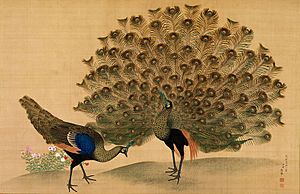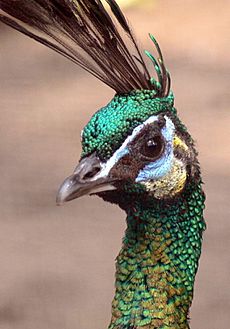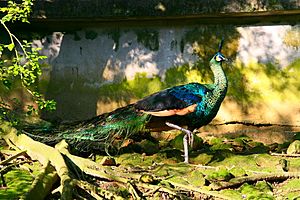Green peafowl facts for kids
Quick facts for kids Green peafowl |
|
|---|---|
 |
|
| Conservation status | |
| Scientific classification | |
| Kingdom: | |
| Class: | |
| Order: | |
| Family: | |
| Genus: | |
| Binomial name | |
| Pavo muticus Linnaeus, 1766
|
|
The green peafowl (Pavo muticus) is a beautiful bird that lives in Southeast Asia. It's known for its bright, colorful feathers.
Contents
All About the Green Peafowl
Green peafowl are quite similar in how they look, especially when you see them in nature. It can be hard to tell the males and females apart for most of the year. Both have tall, pointed crests on their heads. They also have long legs, strong wings, and long tails.
From far away, they look like dark birds. But their pale, reddish-orange or light brown primary feathers (the long flight feathers on their wings) are easy to spot when they fly. They fly differently from many other birds in their group (called Galliforms, which includes chickens and turkeys). Green peafowl flap their wings a lot and don't glide as much.
Male and Female Appearance
Male green peafowl of the imperator and spicifer types are mostly bluish-green. The imperator has a shiny green chest, neck, and wing feathers. The spicifer has a duller, bluer chest and neck, with more black on its wings. The muticus type, found in Java, is more golden-green and has less blue on its neck and chest. The colors can change a bit depending on the bird's age and whether it's a male or female.
Sounds They Make
Male green peafowl have a loud call that sounds like ki-wao. They often repeat this sound. Females make a loud aow-aa call, putting more emphasis on the first part. Males usually call from their resting spots at dawn and dusk.
Size and Flight
Green peafowl are very large birds. They are one of the biggest Galliforms in terms of how long they are and how wide their wingspan is. A male can grow up to 3 meters (10 feet) long, including its long tail feathers, and can weigh up to 5 kilograms (11 pounds). Females are about 1.1 meters (3.5 feet) long and weigh around 1.1 kilograms (2.4 pounds). Their wingspan can be about 1.2 meters (4 feet) wide.
Unlike their relatives, the Indian peafowl, green peafowl are much better at flying. They can fly for longer distances without stopping.
Where Green Peafowl Live
In the past, green peafowl lived across a large area of Southeast Asia. This included places like northern Myanmar, southern China, Laos, Thailand, Vietnam, Cambodia, Peninsular Malaysia, and the island of Java.
However, their homes have shrunk because of habitat destruction (when their natural living areas are destroyed) and hunting. Now, they are a protected species in India, meaning they are safe from hunting there.
Their Homes in Nature
Green peafowl can live in many different kinds of places. They are found in old, untouched forests (called primary forests) and newer forests (secondary forests). They live in both warm, wet tropical areas and slightly cooler subtropical areas. They can also be found in forests that stay green all year or those where trees lose their leaves.
You might also spot them among bamboo plants, in grasslands, savannas, or bushy areas. They sometimes live near the edges of farms. In Vietnam, they prefer dry forests close to water and far away from people. Being near water seems to be very important for them.
Types of Green Peafowl
Scientists recognize three main types, or subspecies, of green peafowl. These are like different "races" within the same species.
- P. m. muticus: This type is found on the island of Java. It used to live in parts of the Malay Peninsula too.
- P. m. imperator: This type lives from Burma (Myanmar) to Thailand, southern China, and Indochina.
- P. m. spicifer: This type is found in northwestern Burma. It used to live in northeastern India and Bangladesh as well.
Today, green peafowl are found in mainland Burma, Yunnan (China), Thailand, Laos, Vietnam, Cambodia, and on the island of Java in Indonesia. They are not found on the islands of Sumatra or Borneo.
How Green Peafowl Behave
Green peafowl are forest birds. They build their nests on the ground and usually lay 3 to 6 eggs.
It was once thought that male green peafowl had many mates and didn't help raise their young. However, observations of peafowl in captivity (in zoos or special centers) show something different. When left alone, pairs of green peafowl often stay together, acting as if they are monogamous (having only one mate). The fact that males and females look so similar also suggests they might have a different family life than Indian peafowl.
Daily Life and Diet
Green peafowl usually spend their time on or near the ground, often in tall grasses. Like other peafowl, they enjoy wading in shallow water to find food for a good part of the day. Families of green peafowl sleep in trees, usually about 10–15 meters (33–49 feet) high.
Their diet mostly includes fruits, invertebrates (like insects and worms), reptiles, and other small animals. Green peafowl can even hunt venomous snakes, which makes them helpful for controlling pests. Adult peafowl love to eat ticks, termites, flower petals, buds, leaves, and berries. Young peafowl probably eat a lot of frogs and other small water animals.
Green peafowl fill a similar role in nature as other birds like the Secretary Bird and bustards. They hunt small animals on the ground in tropical grasslands. Like these other hunting birds, green peafowl are often monogamous and stay with their offspring for a long time. These ground-hunting birds often grow up slowly, have long legs, strong wings, noticeable crests, and long, wide tails.
Who Hunts Them?
Large cats are natural predators of green peafowl. These include the Clouded Leopard, Leopard, Tiger, Jungle Cat, and Fishing Cat. These big cats hunt adult peafowl.
Images for kids
See also
 In Spanish: Pavo real cuelliverde para niños
In Spanish: Pavo real cuelliverde para niños









